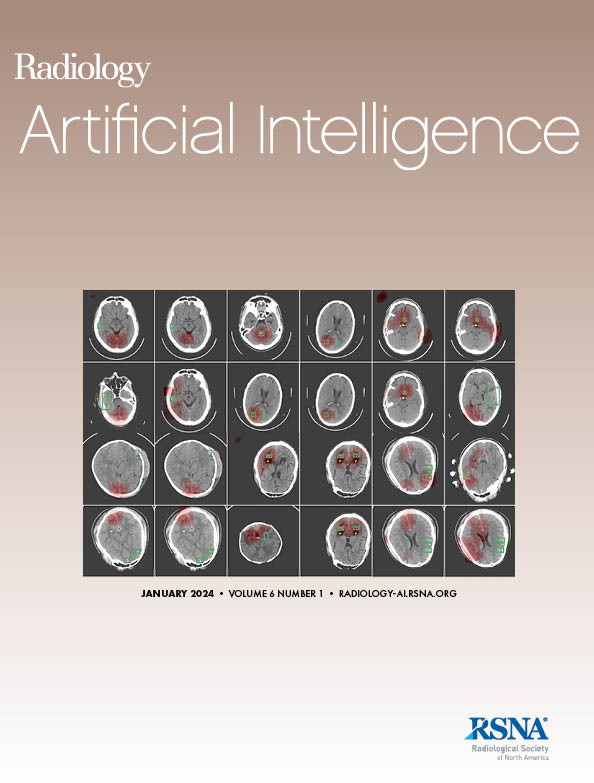Sven Koehler, Julian Kuhm, Tyler Huffaker, Daniel Young, Animesh Tandon, Florian André, Norbert Frey, Gerald Greil, Tarique Hussain, Sandy Engelhardt
下载PDF
{"title":"Deep Learning-based Aligned Strain from Cine Cardiac MRI for Detection of Fibrotic Myocardial Tissue in Patients with Duchenne Muscular Dystrophy.","authors":"Sven Koehler, Julian Kuhm, Tyler Huffaker, Daniel Young, Animesh Tandon, Florian André, Norbert Frey, Gerald Greil, Tarique Hussain, Sandy Engelhardt","doi":"10.1148/ryai.240303","DOIUrl":null,"url":null,"abstract":"<p><p>Purpose To develop a deep learning (DL) model that derives aligned strain values from cine (noncontrast) cardiac MRI and evaluate performance of these values to predict myocardial fibrosis in patients with Duchenne muscular dystrophy (DMD). Materials and Methods This retrospective study included 139 male patients with DMD who underwent cardiac MRI at a single center between February 2018 and April 2023. A DL pipeline was developed to detect five key frames throughout the cardiac cycle and respective dense deformation fields, allowing for phase-specific strain analysis across patients and from one key frame to the next. Effectiveness of these strain values in identifying abnormal deformations associated with fibrotic segments was evaluated in 57 patients (mean age [± SD], 15.2 years ± 3.1), and reproducibility was assessed in 82 patients by comparing the study method with existing feature-tracking and DL-based methods. Statistical analysis compared strain values using <i>t</i> tests, mixed models, and more than 2000 machine learning models; accuracy, F1 score, sensitivity, and specificity are reported. Results DL-based aligned strain identified five times more differences (29 vs five; <i>P</i> < .01) between fibrotic and nonfibrotic segments compared with traditional strain values and identified abnormal diastolic deformation patterns often missed with traditional methods. In addition, aligned strain values enhanced performance of predictive models for myocardial fibrosis detection, improving specificity by 40%, overall accuracy by 17%, and accuracy in patients with preserved ejection fraction by 61%. Conclusion The proposed aligned strain technique enables motion-based detection of myocardial dysfunction at noncontrast cardiac MRI, facilitating detailed interpatient strain analysis and allowing precise tracking of disease progression in DMD. <b>Keywords:</b> Pediatrics, Image Postprocessing, Heart, Cardiac, Convolutional Neural Network (CNN) Duchenne Muscular Dystrophy <i>Supplemental material is available for this article.</i> © RSNA, 2025.</p>","PeriodicalId":29787,"journal":{"name":"Radiology-Artificial Intelligence","volume":" ","pages":"e240303"},"PeriodicalIF":13.2000,"publicationDate":"2025-05-01","publicationTypes":"Journal Article","fieldsOfStudy":null,"isOpenAccess":false,"openAccessPdf":"https://www.ncbi.nlm.nih.gov/pmc/articles/PMC12127955/pdf/","citationCount":"0","resultStr":null,"platform":"Semanticscholar","paperid":null,"PeriodicalName":"Radiology-Artificial Intelligence","FirstCategoryId":"1085","ListUrlMain":"https://doi.org/10.1148/ryai.240303","RegionNum":0,"RegionCategory":null,"ArticlePicture":[],"TitleCN":null,"AbstractTextCN":null,"PMCID":null,"EPubDate":"","PubModel":"","JCR":"Q1","JCRName":"COMPUTER SCIENCE, ARTIFICIAL INTELLIGENCE","Score":null,"Total":0}
引用次数: 0
引用
批量引用
Abstract
Purpose To develop a deep learning (DL) model that derives aligned strain values from cine (noncontrast) cardiac MRI and evaluate performance of these values to predict myocardial fibrosis in patients with Duchenne muscular dystrophy (DMD). Materials and Methods This retrospective study included 139 male patients with DMD who underwent cardiac MRI at a single center between February 2018 and April 2023. A DL pipeline was developed to detect five key frames throughout the cardiac cycle and respective dense deformation fields, allowing for phase-specific strain analysis across patients and from one key frame to the next. Effectiveness of these strain values in identifying abnormal deformations associated with fibrotic segments was evaluated in 57 patients (mean age [± SD], 15.2 years ± 3.1), and reproducibility was assessed in 82 patients by comparing the study method with existing feature-tracking and DL-based methods. Statistical analysis compared strain values using t tests, mixed models, and more than 2000 machine learning models; accuracy, F1 score, sensitivity, and specificity are reported. Results DL-based aligned strain identified five times more differences (29 vs five; P < .01) between fibrotic and nonfibrotic segments compared with traditional strain values and identified abnormal diastolic deformation patterns often missed with traditional methods. In addition, aligned strain values enhanced performance of predictive models for myocardial fibrosis detection, improving specificity by 40%, overall accuracy by 17%, and accuracy in patients with preserved ejection fraction by 61%. Conclusion The proposed aligned strain technique enables motion-based detection of myocardial dysfunction at noncontrast cardiac MRI, facilitating detailed interpatient strain analysis and allowing precise tracking of disease progression in DMD. Keywords: Pediatrics, Image Postprocessing, Heart, Cardiac, Convolutional Neural Network (CNN) Duchenne Muscular Dystrophy Supplemental material is available for this article. © RSNA, 2025.
基于深度学习的Cine心脏MRI对齐应变检测杜氏肌营养不良患者纤维化心肌组织。
“刚刚接受”的论文经过了全面的同行评审,并已被接受发表在《放射学:人工智能》杂志上。这篇文章将经过编辑,布局和校样审查,然后在其最终版本出版。请注意,在最终编辑文章的制作过程中,可能会发现可能影响内容的错误。目的开发一种深度学习(DL)模型,该模型可从电影(非对比)心脏MRI中获得对齐应变值,并评估这些值的性能,以预测杜氏肌营养不良症(DMD)患者的心肌纤维化。材料与方法本回顾性研究纳入了139例男性DMD患者,这些患者于2018年2月至2023年4月在同一中心接受了心脏MRI检查。开发了一个DL管道来检测整个心脏周期的五个关键帧,以及各自的密集变形场,从而允许在患者之间以及从一个关键帧到下一个关键帧之间进行相位特定的应变分析。在57例患者(15.2±3.1年)中评估这些应变值识别与纤维化节段相关的异常变形的有效性,并在82例患者(12.8±2.7年)中评估再现性,将我们的方法与现有的特征跟踪和基于dl的方法进行比较。统计分析使用t检验、混合模型和2000+ ML模型比较应变值、报告准确性、F1评分、敏感性和特异性。结果与传统应变值相比,基于dl的对准应变在纤维化节段和非纤维化节段之间识别出的差异(29比5,P < 0.01)增加了5倍,并识别出了传统方法经常错过的异常舒张变形模式。此外,对齐的应变值提高了心肌纤维化检测预测模型的性能,特异性提高了40%,总体准确性提高了17%,射血分数保留患者的准确性提高了61%。结论提出的排列应变技术可以在无造影剂的心脏MRI上基于运动检测心肌功能障碍,方便详细的患者间应变分析,并可以精确跟踪DMD的疾病进展。©RSNA, 2025年。
本文章由计算机程序翻译,如有差异,请以英文原文为准。

 求助内容:
求助内容: 应助结果提醒方式:
应助结果提醒方式:


